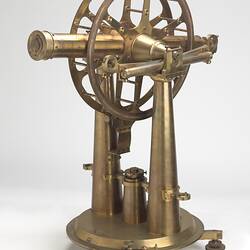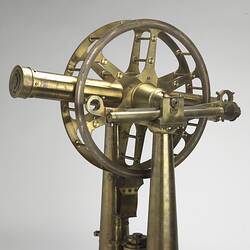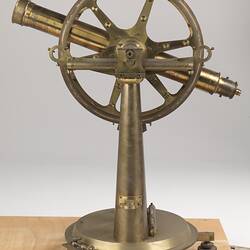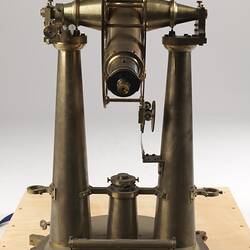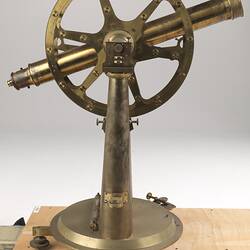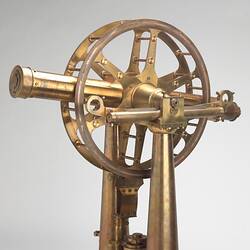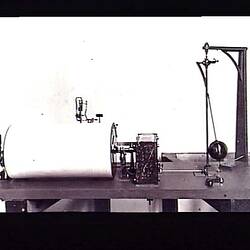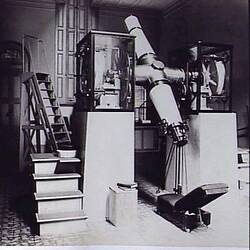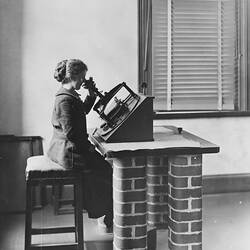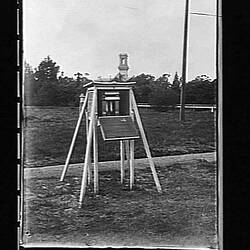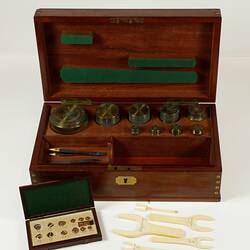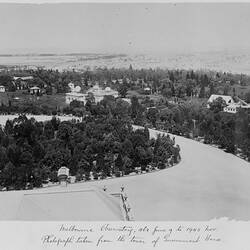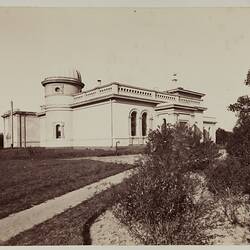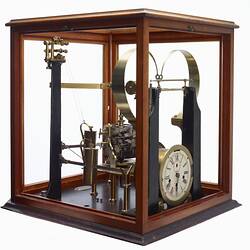Summary
Altitude and azimuth instrument, or altazimuth, 18 inch circle, made by Troughton & Simms, London, circa 1836. This instrument was used for the Geodetic Survey of Victoria, 1858-71, which established the primary surveying points throughout the colony.
The instrument was also used during the observation of the Transit of Venus in December 1874 by E J White, Assistant Astronomer at Melbourne Observatory, who used it to observe the times of the internal contacts of Venus on the Sun's disk.
Physical Description
Circles graduated to 5 min on silver & read by micrometers.
Significance
This altitude and azimuth instrument (or altazimuth telescope) is one of the most important instruments used during the Geodetic Survey of Victoria, 1858-72.
The Geodetic Survey of Victoria was established in 1858 by Surveyor-General Charles Ligar to undertake a triangulated survey of Victoria, taking into account the curvature of the earth's surface. The Geodetic Survey would thereby provide an accurate set of survey markers that could be used by government and commercial surveyors for all subsequent surveys. The Victorian Government Astronomer and Director of Williamstown Observatory and subsequently Melbourne Observatory, Robert Ellery, was placed in charge of the project, because the work required highly accurate measurements and astronomical observations.
A base line for the survey was measured at Werribee, because the Werribee Plains provided the closest relatively flat land near Williamstown. After this was completed in 1860, careful measurements using this altitude and altazimuth instrument and smaller instruments spread the triangulations slowly across the colony. The Geodetic Survey took a further 12 years to complete, Surveying in heavily wooded and hilly areas such as Gippsland proved to be very time consuming, requiring the use of heliotropes directing light from mountain to mountain.
This instrument was made by Troughton & Simms of London, the leading British firm of surveying and astronomical instruments. The instrument consists of a telescope mounted so that it pivots both horizontally and vertically. With its 18 inch vertical and horizontal circles it could accurately measure both angles of altitude and azimuth. The circles have a silver scale accurately divided into 5 minutes of arc (one-twelfth of a degree), which could then be read still more accurately using small reading microscopes.
Made of thick brass, the instrument was extremely heavy and had to be carried in two large crates. Robert Ellery gradually shifted to using lighter theodolites with 15 inch circles made by the German instrument making firm Ertel & Sohn.
This instrument continued to be used as a portable telescope for astronomical observations, both at Melbourne Observatory and on observing expeditions. For example it was used by assistant astronomer Edward White to observe the Transit of Venus in 1874.
More Information
-
Collection Names
-
Collecting Areas
-
Acquisition Information
Transfer from Melbourne Observatory, 1945
-
User
Troughton & Simms, London, Middlesex, England, Great Britain, circa 1836
-
User
Williamstown Observatory, Williamstown, Greater Melbourne, Victoria, Australia, 1859-1863
Used in Geodetic Survey of Victoria, directed by Robert Ellery, Government Astronomer at Williamstown Observatory. -
User
Victoria: Geodetic Survey of Victoria, Victoria, Australia, 1858-1871
-
User
Melbourne Observatory, South Yarra, Greater Melbourne, Victoria, Australia
-
Inscriptions
Marked "S.G.O. 100". S.G.O. stands for Surveyor-General's Office.
-
Classification
Surveying & navigation, Optical - surveying, Angular measurement
-
Category
-
Discipline
-
Type of item
-
Overall Dimensions
80 cm (Length), 52 cm (Width), 105 cm (Height)
-
Exhibition Collection Management
960 mm (Length), 510 mm (Width), 800 mm (Height), 200 (Weight)
-
Dimensions
57 cm (Length), 49 cm (Width), 102.5 cm (Height)
Measurement From Conservation. Measuring Method: Telescope fastened in resting position.
-
Maximum dimensions
765 mm (Length), 510 mm (Width), 940 mm (Height)
Measurement From Conservation.
-
Keywords
Geodetic Surveys, Surveying Apparatus & Instruments, Theodolites

